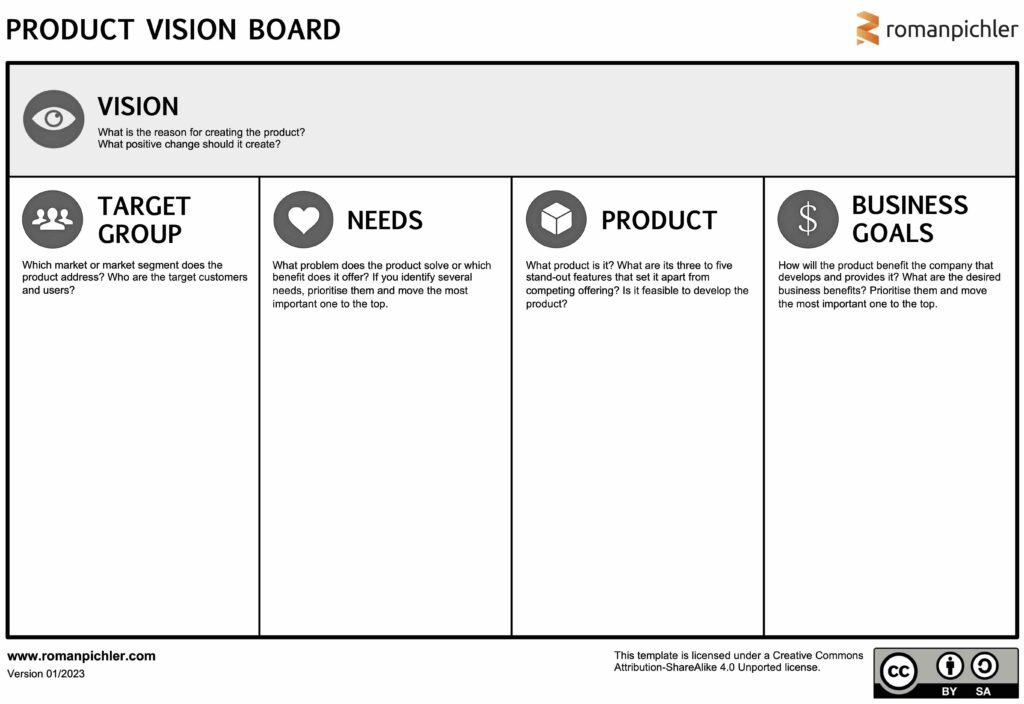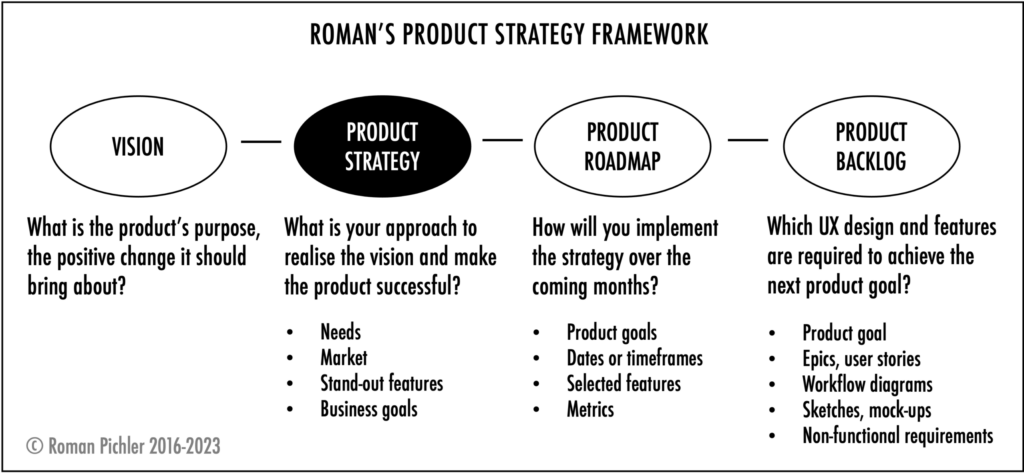The product strategy is possibly the most important product management plan. But what exactly is it? Which information should it contain? Do you need a strategy for your product? How can you ensure that it is likely to result in a successful product and how do you keep it up to date? These are the questions I am going to answer in this article.
Listen to the audio version of this article:
What Information Should a Product Strategy Provide?
I like to think of the product strategy as a high-level plan that helps you realise your vision and that answers the following four questions:
- Who is the product for? Who are the users and, if appropriate, who are the customers?
- Why would people want to use and buy it? What specific problem does it address, or which tangible benefit does it offer?
- What kind of product is it and what makes it stand out? How does it differ from competing offerings? Why would people choose it over alternatives?
- What are the business goals? Which benefits does the product create for the company developing and providing it?
To make these recommendations more concrete, let’s look at an example. Say that I want to develop a product that helps people eat more healthily. To create a strategy, I might choose middle aged men with busy jobs and an unhealthy lifestyle as the target users. The benefit the product should create for this user group might be to reduce the risk of developing type-2 diabetes. The product might be a mobile app, and its standout features might include measure and record sugar levels in food, analyse eating habits and make individualised recommendations, and seamlessly integrate with leading smart scales. The business benefits, finally, might be to create a new revenue stream, diversify the business, or develop the company brand.
To capture the product strategy, you can use my product vision board. It’s a tool I have developed specifically to help people describe the vision and strategy of their products. You can download the product vision board from my website and by clicking on the image below. If you want to learn more about the tool, then read my article The Product Vision Board or watch my video Introduction to the Product Vision Board.
How Does the Strategy Relate to the Vision and Roadmap?
Another approach to define the product strategy is to explore how it relates to other product plans. To do this, let’s take a look at my product strategy framework shown below.
As the image above shows, the product strategy sits between the vision and the product roadmap in my model. To put it differently, it states how you intend to realise the vision and thereby make the product successful, and it provides the necessary input to create an actionable product roadmap. The roadmap, in turn, provides the context to discover the right product details and capture them in the product backlog. You can learn more about the framework by reading the article My Product Strategy Model.
Do You Need a Strategy for Your Product?
Now, you might be wondering if you need a product strategy at all. Without a product strategy, you will struggle to explain how your product creates value; you will find it difficult to come up with a realistic product roadmap; and you will have a hard time determining the product details. How can you capture the right user stories, for example, if you don’t know for sure who the users are and why they would want to use your product? Finally, it will be hard to select the right key performance indicators (KPIs) and measure how much value your product creates—the product strategy forms the basis for choosing the correct KPIs. I therefore recommend that every product has a strategy. If that’s not the case for your offering, then you should create one, for example by using the product vision board template shown above.
How Can You Create a Strategy that likely to Result in a Successful Product?
It’s great to have an initial product strategy. But to increase the chances that it will result in a successful product—a product that is desirable, feasible, viable, and ethical product—you should test your plan. A great way to achieve this is to start with an initial strategy and to iteratively validate and change it, as the picture below illustrates.
The process above—which is loosely based on Eric Ries’ work—consists of the following four steps: First, identify the biggest risk currently contained in the product strategy. That’s the uncertainty that must be addressed now to make the right strategic decisions. A sample risk might be that the target group is not big enough or that the need identified may not be compelling enough. Second, determine the right method to address the risk such as direct observation and user interview. Third, apply the method and collect the relevant data, for example, carry out the user interviews and capture the answers in the form of notes or video footage. Fourth, evaluate the data and use the insights gained to decide how to proceed: persevere, pivot, or stop.
Persevere means sticking with the strategy, possibly making smaller changes, and addressing the next risk. Pivot entails changing the strategy, for example, writing a book on healthy eating rather than developing an app to build on the example used earlier. Stop, finally, means what it says: to stop working on the product strategy and looking for a new idea. For a more detailed explanation of how to create and iteratively validate a product strategy, refer to my book Strategize.
How Do You Keep the Product Strategy Relevant and Up to Date?
Finally, the product strategy is not a fixed, static plan that simply has to be implemented. Instead, it is changeable and dynamic. As new technologies emerge, as competitors offer new products or update existing ones, and as users’ needs evolve, your strategy has to change in order to proactively guide the product delivery and maximise the chances of offering a successful product. You should therefore regularly review your product strategy. The following four factors will help you with this.
- Performance: How your product doing based on its key performance indicators (KPIs)?
- Trends: Are there any new technology, regulatory, or social developments that will affect your product?
- Competition: Are your competitors launching new products or features? Is your product still sufficiently differentiated?
- Company: Are there any significant changes in your company that affect the product strategy? For example, has the business strategy changed or have key people left?




Post a Comment or Ask a Question
4 Comments
During team bootups, I often ask the leadership to come in and build a Product Vision Board with the team. Any other ideas on how to bridge the middle space between leadership and the delivery teams? There always seems to be some interface boundary in there.
Thanks for your question Dana. The person in charge of the product, the product manager or Scrum product owner, should lead the strategizing effort and involve the right people in the right way. I am a big fan of collaborative strategizing–bringing the key stakeholders and development team representatives together in the form of a collaborative workshop and seeking agreement on key decisions. But I am not sure why you would lead the leadership team to be actively involved unless you lack the expertise or the empowerment to make the right decisions. Hope this helps!
Very refreshing article and crafted for understanding. Thank you Roman
You’re welcome Zion. Thank you for sharing your feedback. I am glad that you liked the article.